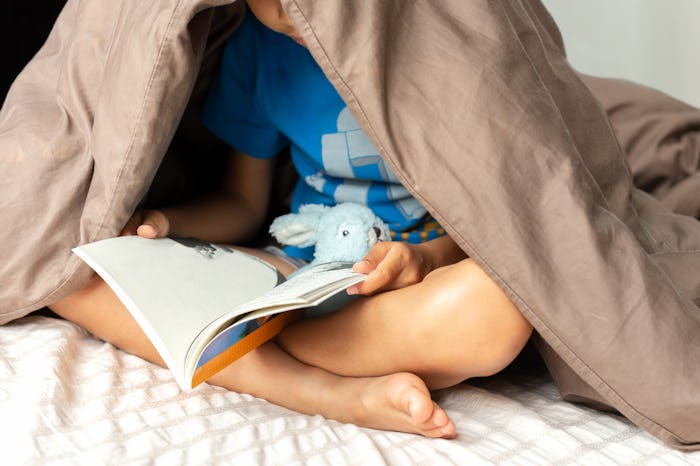Life

Hiding Under A Blanket Is The Ultimate Safe Haven, & Science Has A Reason Why
I remember when my big sister was in the play Annie, she got to wear a fancy curly wig. But more than the wig, I remember the wig holder: a foam, faceless head. That eyeless, floating face would stare out at me from our closet like an alien specter coming to eat my soul. At night, as soon as I spied it, under my covers I would go. Because everyone knows that Strawberry Shortcake comforters offers the ultimate in shield protection. I’m pretty sure they’re also utilized by Navy Seals. In all seriousness... exactly why do blankets feel so safe?
Most of us have witnessed a child pulling the covers over her head to hide from a monster. Or like me, they may remember doing it themselves. Is it an attempt to recreate the tight protection of a swaddle? A desire to crawl back into the womb? Romper spoke with Dr. Tovah Klein, the Director of the Barnard College Center for Toddler Development and author of How Toddlers Thrive: What Parents Can Do Today for Children Ages 2-5 to Plant the Seeds of Lifelong Success. Klein offered some interesting insights on the matter: “Young children like to make the world around them smaller. There is so much to see, hear, learn about in the world, and often little ones can feel out of control. Tents, blankets, small spaces help them feel safer. Hiding under a blanket is something they have control of, ‘I decide when to hide; I decide when to come back’ and it is a small and cozy space.”
So a desire to control their environment is part of what creates this feeling of duvet-as-safe haven. But Klein says there’s also an aspect that allows children to play with the concept of separation. “When they hide, they go away, just like their parents do when they say good-bye. And then when the child returns from hiding, it is a reminder that they always come back, just as mommy and daddy do. You see this when they pop back out of the blanket and there can be so much joy. This is the joy of 'I came back!' which is the reassurance that mommy or daddy come back, too.”
Rather fascinating to think that from such a young age, humans are wrangling such enormous life lessons from a large piece of fabric from Target, no?
But the idea of a blanket as a source of safety and comfort appears to translate to adulthood as well, if one considers the recent weighted blanket craze. USA Today reported that the sale of these extra heavy blankies is only expected to increase in 2019. Perhaps adults are hoping that if they just get one heavy enough, monsters won’t be able to lift it? Possibly. But more likely, they’re looking for a serotonin fix. According to Live Science, weighted blankets “stimulate the release of serotonin and dopamine, two neurotransmitters that tend to make people feel more relaxed." Some research suggests that slow and gentle touch can stimulate portions of the limbic system, the brain's network for processing emotion and fear.
So the idea of a blanket as an object of safety is very wrapped up in (see what I did there?) our psychological and physical responses to them. Also, let us not forget this very important scientific fact pointed out by Dr. Klein, which is that “blankets are soft and cozy.”